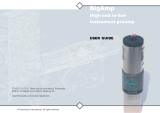
User Guide - 5
English
performers singing toward each other. The strong
off-axis rejection (roughly 40dB of attenuation) can
make it useful for, say, mic’ing a drum kit if you want
to isolate individual drums or cymbals. Moreover,
the Sputnik’s figure-8 pattern is very symmetrical,
which make it a perfect candidate for use in mid-
side (“M/S”) recording—a technique used to capture
very accurately a stereo image with excellent mono
downmix compatibility.
Attenuation and Filter Controls
The Sputnik contains a switchable 10dB attenuation
pad, useful for situations where the sound you are
capturing is sufficiently loud that it may overdrive
some part of the audio signal chain.
Additionally, there is a switchable 80-Hz 2nd-order
high-pass rolloff filter (12dB/octave) for filtering out
such annoyances as low-frequency rumble from traffic
noise outside your studio, or vibrations transmitted
up the mic stand from a player tapping his or her foot.
We advise you to use this function judiciously since
you may be capturing a sound source with valuable
information below 80Hz; furthermore, please
remember that the less circuitry you introduce into
the signal path, the cleaner your output signal will
be—so you should consider switching in the high-
pass filter as a “last resort” problem-solving tactic.
For many applications, the M-Audio shock mount will
successfully reduce the noise from low-frequency
vibrations.
Vacuum Tube Amplifier
In addition to the capsule, the Sputnik’s Class-A head
amplifier is a key element in the microphone’s vintage
sound. It picks the audio signal off the capsule and
conditions it so that it can be sent out the microphone
cable to an appropriate mic preamp. Its main
ingredient is a low-current hand-selected military-
grade 6205M vacuum tube—a diminutive pentode
wired as a triode. What’s notable about this amplifier
circuit is that it’s an all-discrete transconductance
design based on thermionic studies by researchers
at Harvard University and the American Institute of
Physics. The amplifier uses a classic cascode circuit
to increase the gain-bandwidth product and eliminate
the effects of parasitic capacitances (the "Miller
Effect")—giving the system a very wide frequency
response. There are lots of benefits to this circuit
for a microphone because it yields a high output
impedance which makes the mic very tolerant of load
conditions. (The output impedance of the Sputnik’s
cascode circuit is in the mega-ohms—dominated
by the plate resistor—so it behaves like a perfect
current source.)
Also noteworthy about the Sputnik’s head amp is that
the cascode topology uses both the aforementioned
vacuum tube and an n-channel depletion-mode JFET.
The 6205M tube is on the top (with the JFET at the
cathode) so the amp exploits the best properties
of each device. In terms of voltage, the tube is
actually doing all of the heavy lifting and it allows
the overall circuit to maximize headroom and give
the widest possible bandwidth. Furthermore, the
JFET biasing ensures that you don't get all the nasty
artifacts from the tube that you might otherwise
get—like microphonics, hum, crackle, etc. (The fact
that it’s a subminiature military-grade tube—hand-
selected, tested, and burned for a week to ensure
top performance—also minimizes these undesirable
artifacts.)
The amp output feeds a custom-wound nickel-
core output transformer, magnetically shielded to
eliminate RF interference. The transformer’s high
relative permeability (µ
r
) contributes to the Sputnik’s
low distortion characteristics and notable dynamic
range, and it provides a comfortable 200Ω output
impedance.
In essence, the Sputnik’s vacuum tube circuitry delivers
ultra-smooth harmonic detail and can respond very
quickly to signals with fast rise/fall times coming off
the capsule (thereby eliminating transient problems).
The amp is quite linear and features graceful overload
characteristics and an enormous dynamic range due
to its high voltage operation. You can't achieve these
results with a standard transistor amplifier or one of
the more common Class-A vacuum tube designs.
Power Supply
The Sputnik power supply features a sophisticated
circuit designed to ensure optimal performance of
the Sputnik mic and audio signal path. The power
supply charges the parallel-plate capacitor formed
by the diaphragm and backplate of the capsule. The
power supply also provides the operating voltages
needed for the head amp. It starts up slowly by
heating the tube’s cathode (filament) first and then
it ramps up the voltage on the anode (plate)—which
is why the power supply’s LED indicator lights up
gradually, over a 15-second period, to indicate when
the Sputnik is “ready for launch.”
Additionally, the power supply has an automatic
load-sensing circuit that compensates for varying
transmission line impedances—so you can run cables
as long as 200 feet.











